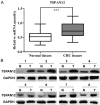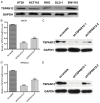Upregulation of TSPAN12 is associated with the colorectal cancer growth and metastasis
- PMID: 28337310
- PMCID: PMC5340717
Upregulation of TSPAN12 is associated with the colorectal cancer growth and metastasis
Abstract
Tetraspanin 12 (TSPAN12), as an earliest member of tetraspanin family, has been recently shown to be highly expressed in several malignant tumors, such as lung cancer and breast cancer, which plays an important role in regulating cell proliferation, migration and invasion. However, the functional roles of TSPAN12 in colorectal cancer (CRC) remain largely unclear. In this study, the expression of TSPAN12 was up-regulated compared to that in paracarcinoma tissues. Higher TSPAN12 expression was significantly correlated with TNM stage, tumor size and lymph node metastasis. The vitro functional analysis, including MTT, colony formation, flow cytometry and transwell assays indicated that lentivirus-mediated TSPAN12 knockdown significantly suppressed cell proliferation, migration and invasion, induced cell apoptosis of CRC cells. In addition, knockdown of TSPAN12 remarkably decreased the growth of subcutaneously inoculated tumors in nude mice. Our findings for the first time supported that TSPAN12 might play a positive role in the regulation of CRC cell proliferation, migration and invasion. The inhibition of TSPAN12 may serve as a novel promising therapeutic strategy against human CRC.
Keywords: Colorectal cancer; TSPAN12; cell proliferation; invasion; shRNA.
Figures






References
-
- Jemal A, Bray F, Center MM, Ferlay J, Ward E, Forman D. Global cancer statistics. CA Cancer J Clin. 2011;61:69–90. - PubMed
-
- Sung JJ, Ng SC, Chan FK, Chiu HM, Kim HS, Matsuda T, Ng SS, Lau JY, Zheng S, Adler S, Reddy N, Yeoh KG, Tsoi KK, Ching JY, Kuipers EJ, Rabeneck L, Young GP, Steele RJ, Lieberman D, Goh KL Asia Pacific Working Group. An updated Asia pacific consensus recommendations on colorectal cancer screening. Gut. 2015;64:121–132. - PubMed
-
- Chua YJ, Zalcberg JR. Progress and challenges in the adjuvant treatment of stage II and III colon cancers. Expert Rev Anticancer Ther. 2008;8:595–604. - PubMed
-
- Speetjens FM, Zeestraten EC, Kuppen PJ, Melief CJ, van der Burg SH. Colorectal cancer vaccines in clinical trials. Expert Rev Vaccines. 2011;10:899–921. - PubMed
-
- de la Chapelle A. Genetic predisposition to colorectal cancer. Nat Rev Cancer. 2004;4:769–780. - PubMed
LinkOut - more resources
Full Text Sources
